Parent page: Managed Domain Models
Altium Designer, in conjunction with your managed content server, caters for the ability to create and manage 3D Model Items in that Server. Used in a similar fashion to file-based linked 3D models, a managed 3D Model Item can hold a 3D model file, that is then referenced through a 3D body attached to a standard 2D footprint. Once a 3D Model Item has been created (and data uploaded into a revision of it), and its lifecycle state set to a level that the organization views as ready for use at the design level, it can be reused in future board-level design projects.
Folder Type
When creating the folder in which to store a 3D Model Item, you can specify the folder's type. This has no bearing on the content of the folder - uploading will always result in a 3D Model Item. It simply provides a visual 'clue' a s to what is stored in a folder and can be beneficial when browsing a Server for particular content. To nominate a folder's use as a container for 3D Model Items, set its Folder Type as 3D Models, when defining the folder properties in the Edit Folder dialog.
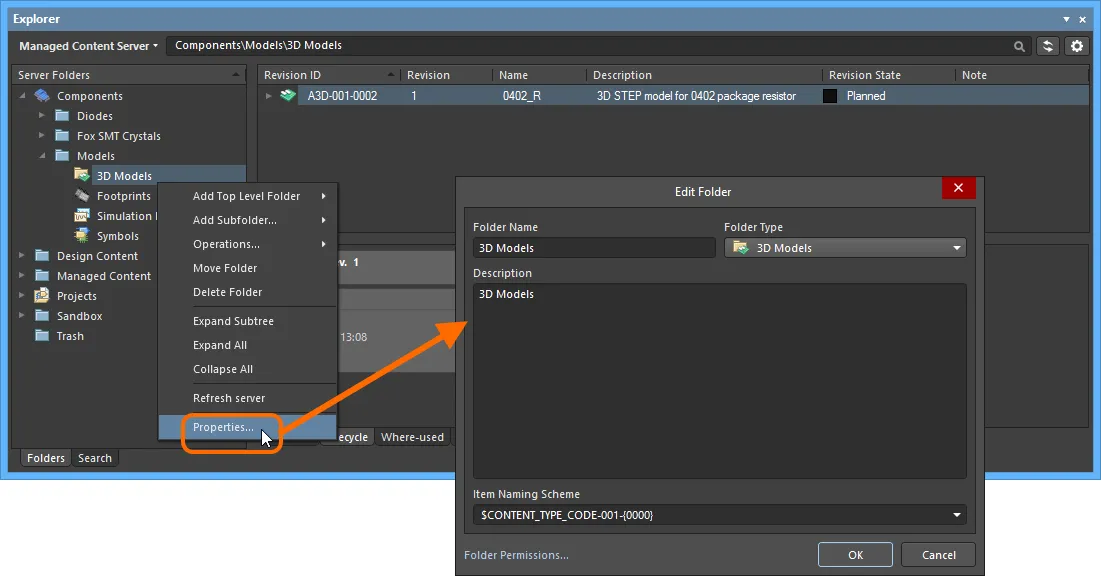
Specifying the folder type - its intended use - gives a visual indication of the content of that folder when browsing the Server!
Item Naming Scheme
Another important aspect of the parent folder is the Item Naming Scheme employed for it. This defines the format of the unique ID for each Item created in that particular folder. Several default example schemes are available, utilizing the short-form code for either the folder type (A3DL - Altium 3D Library) or the content type (A3D - Altium 3D):
- $CONTENT_TYPE_CODE-001-{0000} - for example, A3D-001-0001.
- $CONTENT_TYPE_CODE-001-{A00} - for example, A3D-001-A01.
- $FOLDER_TYPE_CODE-001-{0000} - for example, A3DL-001-0001.
- $FOLDER_TYPE_CODE-001-{A000} - for example, A3DL-001-A001.
Using a default naming scheme, the software will automatically assign the next available unique ID, based on that scheme, having scanned the entire Server and identifiers of existing Items. This can be a great time-saver when manually creating 3D Model Items.
A custom scheme can also be defined for a folder by typing it within the field, ensuring that the variable portion is enclosed in curly braces (e.g. STEP3D-001-{0000}).
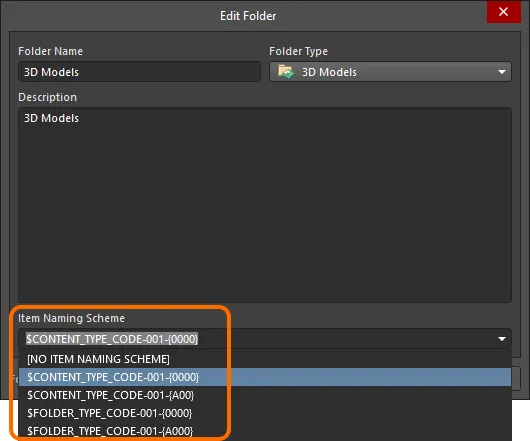
The Item Naming Scheme of the parent folder is applied to the Unique ID for each Item
created within that folder.
The Item Naming Scheme employed for the parent folder can be changed at any time. The modified scheme will then be applied to any subsequent newly-created Items within that folder.
Item Type
When creating the target 3D Model Item in which to store your 3D model file, ensure that its Content Type is set to 3D Model, in the Create New Item dialog. If you are creating the Item in a 3D Models type folder, this Item type will be available from the right-click context menu when creating the Item.
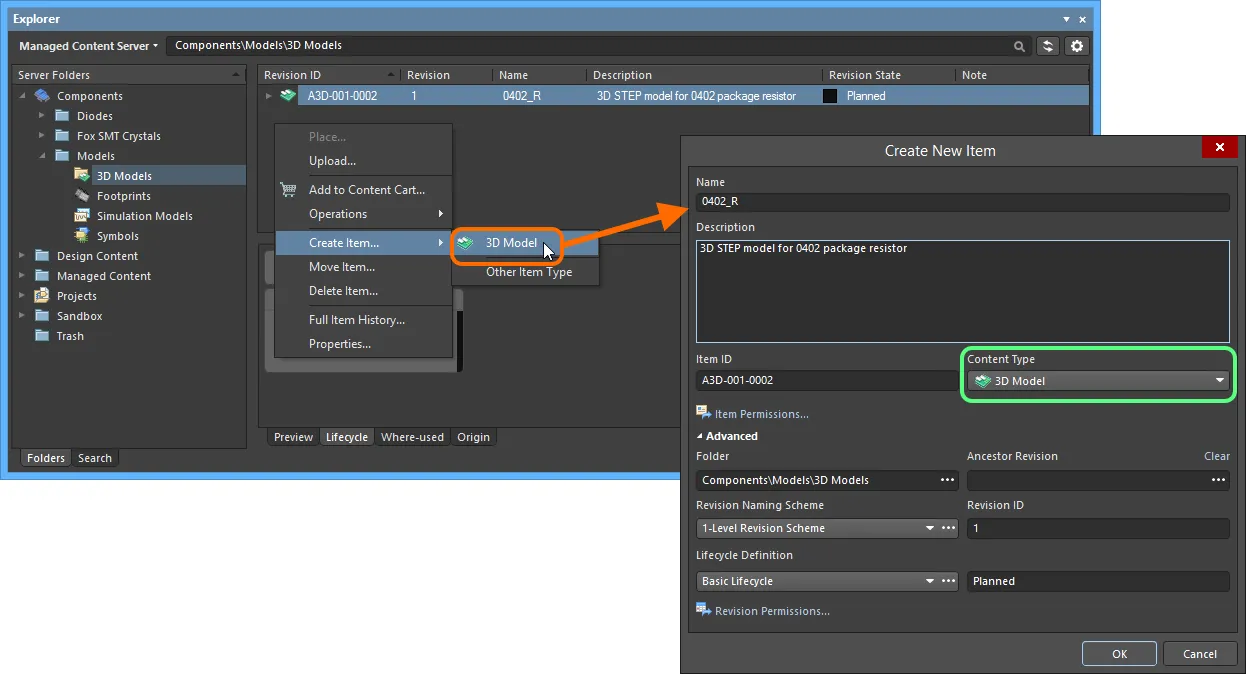
Creating a 3D Model Item within a 3D Models folder - the correct Content Type is available on the context menu.
Item Lifecycle Definition and Revision Naming
When defining the 3D Model Item, to which the source 3D model file is uploaded, be sure to specify the type of lifecycle management to be used for the Item, and the naming scheme employed for its revisions, respectively.
Control over which Item types can use a particular lifecycle definition or revision naming scheme, can be defined and enabled at a global level from within the Content Types dialog, when defining each schema. The default schemes assigned for use by a 3D Model Item are: Basic Lifecycle and 1-Level Revision Scheme, respectively.
Once a 3D model file has been uploaded into the initial revision of a 3D Model Item, these schemes cannot be changed for that particular Item.
Specify the required schemes in the Create New Item dialog, using the Lifecycle Definition and Revision Naming Scheme fields respectively.
If the option to control use of lifecycle definitions and revision naming schemes per content type is enabled for any definitions/schemes, and the 3D Model Item type is not set to use a particular definition/scheme, then that definition/scheme will not be available in the applicable drop-down list.
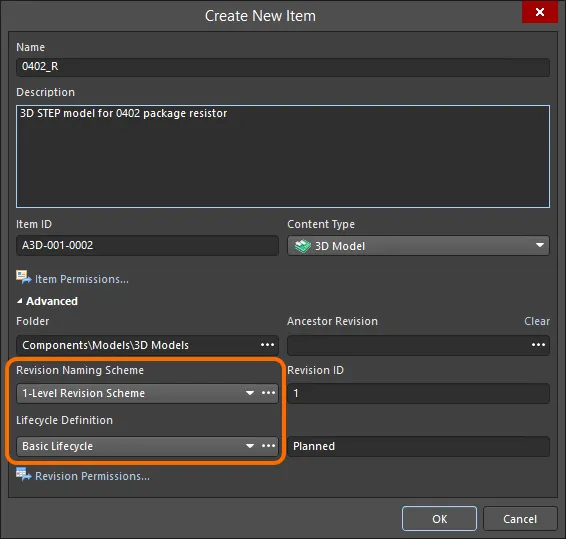
Selecting the Lifecycle Definition and Revision Naming schemes for a manually created Item.
Observing standard revision naming schemes and lifecycle definitions, across the various types of design item in a managed content server ensures smooth, consistent management of those items.
It is a good idea to add a Name and Description as part of the Item's definition. This information is used when searching the Server and enables quick identification of what a 3D Model Item offers.
Uploading a 3D Model File
So far, we've discussed the support for a 3D Model Item in the Server, in terms of related folder and item types. Uploading a 3D model file into the revision of such an item can be performed in a couple of ways.
Upload Menu
A 3D model file can be uploaded by right-clicking on the required 3D Model Item in the Explorer panel, and choosing the Upload command from the context menu. The Create New Revision dialog will appear, in which you can change Name, Description, and add release notes as required. Use the Sources region of the dialog to load the required model file. This can be performed by dragging and dropping the file from Windows Explorer, onto the region. Alternatively, click the  button - the Add Files dialog (a standard Windows open-type dialog) will appear. Use this to browse to, and open, the required model file.
button - the Add Files dialog (a standard Windows open-type dialog) will appear. Use this to browse to, and open, the required model file.
Supported formats are:
- STEP File (*.step; *.stp)
- Parasolid File (*.x_t; *.x_b)
- SolidWorks Part File (*.sldprt)
If the Item has no planned revision, upload will be to the next planned revision, created on-the-fly as part of the upload process.

Manually specifying the 3D model file to be uploaded to the target 3D Model Item.
Once the desired file is dropped in, or selected and the Open button clicked, an entry for it will appear back in the Sources region. Proceed with the upload by clicking the OK button. The graphical depiction of the uploaded model can be viewed in the Preview aspect view for the Item Revision, in the Explorer panel.

Browse the released revision of the 3D Model Item, back in the Explorer panel. Switch to the Preview aspect view to see its graphical depiction.
Drag and Drop from Windows Explorer
A 3D model file can also be uploaded by dragging the selected file from a source folder in your Windows Explorer, and dropping onto the required target 3D Model Item in the Explorer panel. The Create New Revision dialog will appear, with the dragged file listed in the Sources region. Add any Release Notes as required, and then click the OK button.
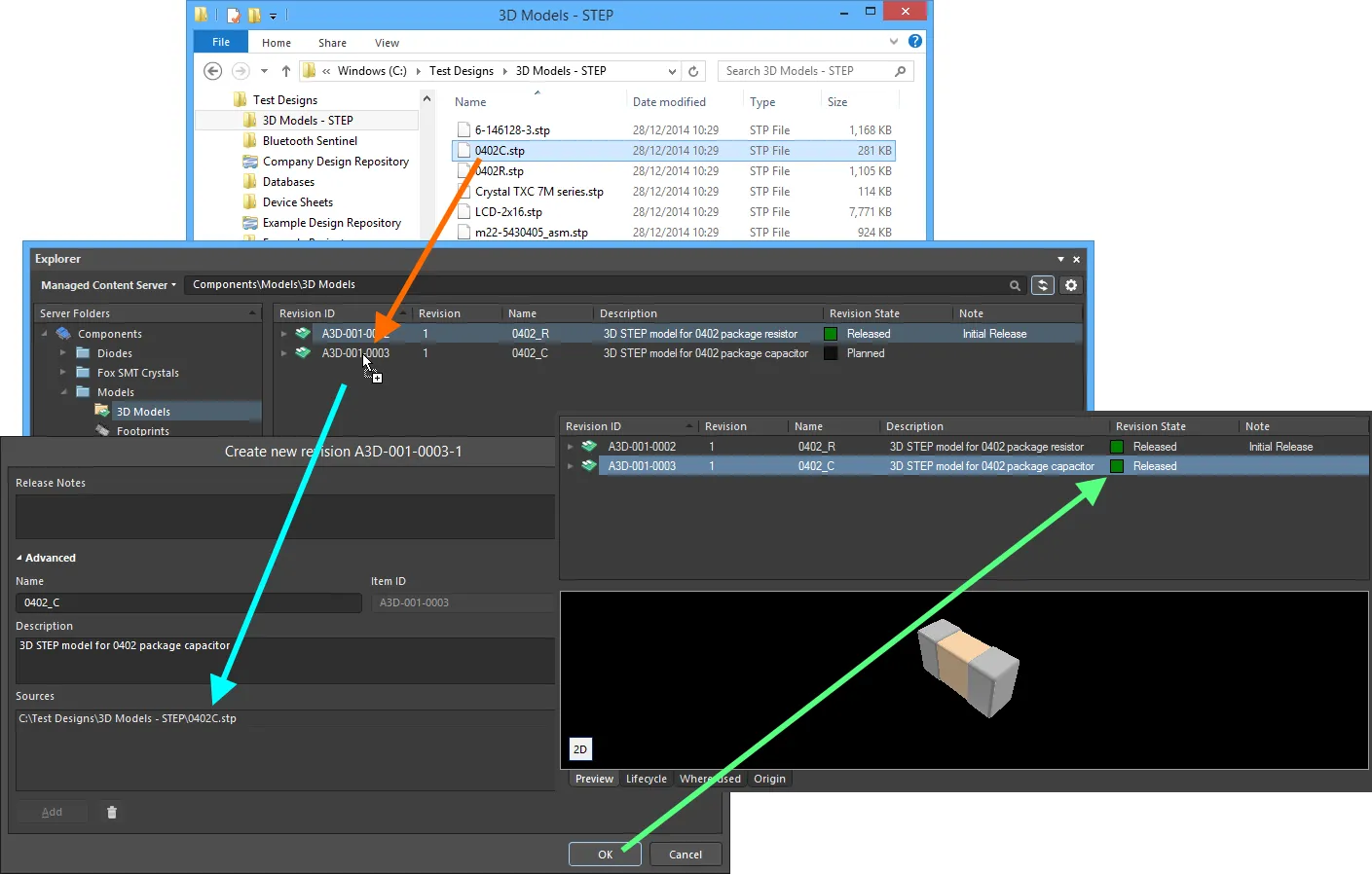
Uploading a 3D model using the drag and drop method.
If the existing 3D Model Item has no planned revision, upload will be to the next planned revision, created on-the-fly as part of the upload process. If you drop the dragged model away from an existing Item, a new 3D Model Item will be created. The
Create New Item dialog will appear. The
Name of the item will be the file name. The
Description will be the file name (with extension). Change these as required. The
Item ID will be in accordance with the Item Naming scheme defined at the folder level. If the folder has no naming scheme defined, naming will follow the
$CONTENT_TYPE_CODE-001-{0000} scheme.
If you attempt to drag and drop more than one 3D Model file, the
Release Manager dialog will automatically launch. Use this to complete upload of multiple models.
Reusing a Managed 3D Model Item
Related page: Controlling Access to Server Content
Once a 3D model file has been uploaded to a managed content server, and its lifecycle state set to a level that the organization views as ready for use at the design level, that 3D model can be reused in future board-level design projects.
A 3D body is used to provide the three-dimensional representation of the component in the PCB domain, and is typically placed and defined in conjunction with the standard 2D footprint model, when defining a footprint model (which is then released to the managed content server as a revision of a target Footprint Item).
The quickest, and easiest way to use a revision of a 3D Model Item, is to place it directly from the Server into a PCB or PCB Library document, creating a 3D Body object that references that Item Revision. The 3D Body object can then be fine-tuned as required. To place:
- Ensure a PCB Library (or PCB) document is open as the active design document.
- Right-click on the required revision of the 3D Model Item and choose the Place command from the context menu.
Right-click and Place the top-level entry for an Item itself, to place an instance of the latest revision of that Item.
Conversely, if you are defining the 3D Body object, and want to reference a 3D model that is stored in a managed content server, this can be done from within the Properties panel, when defining the properties for the body.
To do so:
- In the 3D Model Type region of the panel, choose the Generic option.
- In the Source region of the panel, choose the Vault option.
- Click the
 button to the right of the Item Revision field. This gives access to the Choose Item dialog (essentially an incarnation of the Explorer panel). Use this dialog to browse to, and select, the revision of the required 3D Model Item. After clicking OK, a link will be created between the 3D Body and the target revision of the 3D Model Item. Evidence of this link can be seen back in the Properties panel. Note that the Identifier field for the 3D Body will be filled with the Item-Revision ID of the linked 3D Model Item.
button to the right of the Item Revision field. This gives access to the Choose Item dialog (essentially an incarnation of the Explorer panel). Use this dialog to browse to, and select, the revision of the required 3D Model Item. After clicking OK, a link will be created between the 3D Body and the target revision of the 3D Model Item. Evidence of this link can be seen back in the Properties panel. Note that the Identifier field for the 3D Body will be filled with the Item-Revision ID of the linked 3D Model Item.
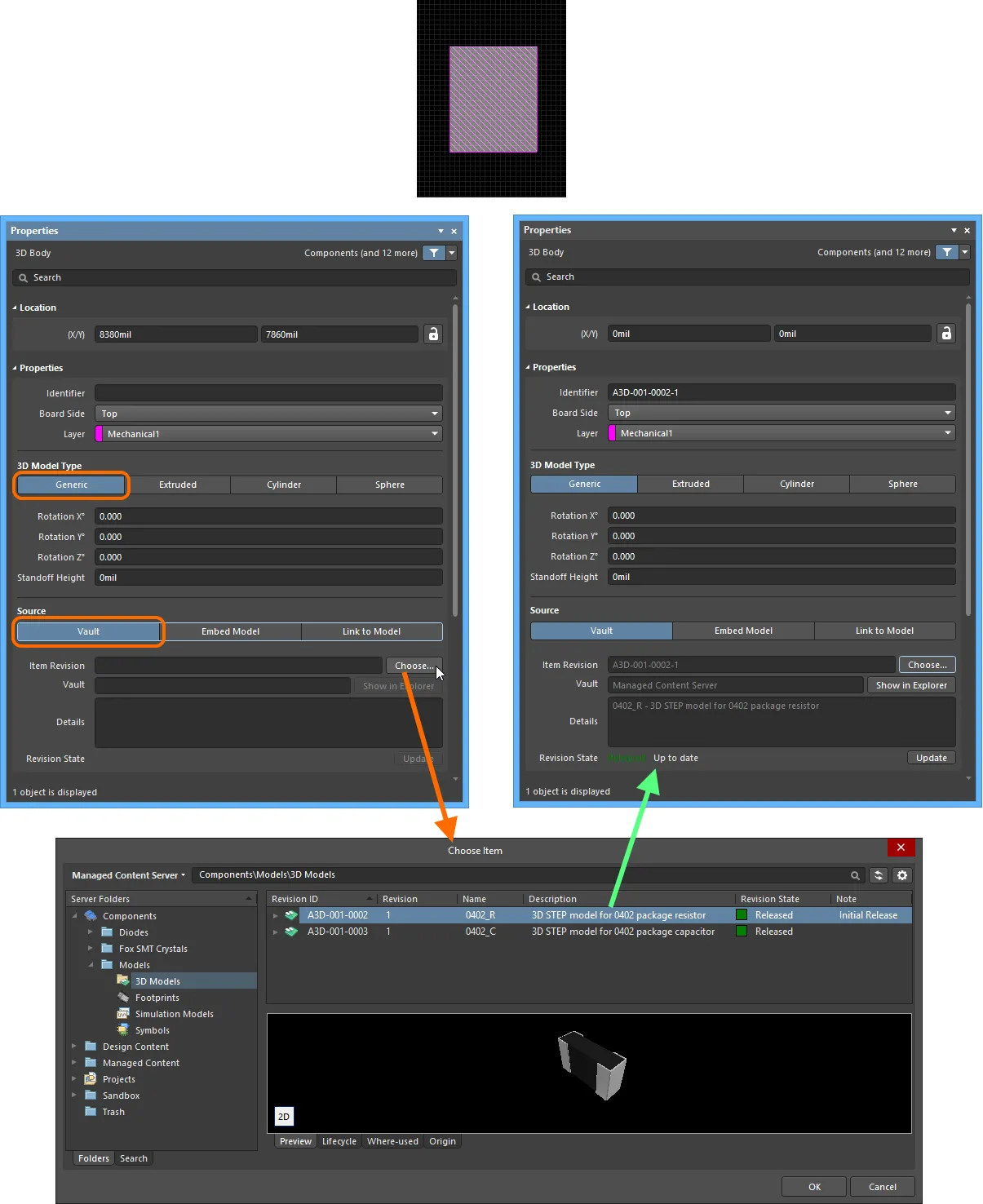
Manually linking the 3D Body object to a revision of a 3D Model Item, in the target Server.
The 3D Model Item being used can be changed at any time - click

and select a revision of a different 3D Model Item.
The status of the linked 3D Model Item is reflected on the
Properties panel. If a newer revision of the linked Item is available, click the

button, to use that latest revision.
Releasing a PCB 2D/3D Component Model into the Server
When directly editing the source 2D footprint model stored within a revision of a Footprint Item - within a temporary PCB Library Editor - you can define a 3D Body object for it, with that body referencing (linked to) a revision of a 3D Model Item in a managed content server. The following happens upon release of that footprint model:
- The 3D Model link is detected and the revision of the 3D Model Item will appear listed as a child Item of the Footprint Item, in its Children aspect view.
- The revision of the 3D Model Item is detected as 'being used' and will therefore list the parent Footprint Item in its Where-used aspect view.
Updating a 3D Model Item
If you need to change the 3D model stored in a 3D Model Item, upload the required new model to that Item - the new model will be stored in the next revision of that Item.
Updating Related Footprint Item Revisions
When you make a change to a 3D model, the moment you upload that change into a new revision of the 3D Model Item, any Footprint Item revisions that use that model will become effectively out of date, still using the previous revision. In most cases, you will no doubt want to re-release those footprints, with the respective model links updated to use the latest revision available. To streamline this process, your managed content server, in conjunction with Altium Designer, facilitates the ability to update related Footprint Item revisions - at the point of uploading to the latest revision of the 3D Model Item.
Once uploaded, if any Footprint Item revisions currently reference the Item, a dialog will appear asking whether or not you wish to update those items.
If you want to keep all related Footprint Item revisions using the current revision of the 3D Model Item, click No in the dialog. Only the model itself will then be uploaded.
A PCB Library document is then opened in its associated temporary editor (for direct editing). When multiple Footprint Item revisions use the 3D Model Item, rather than separate instances of PCB Libraries being opened, a single PcbLib document is presented, containing all affected PCB 2D/3D component models.
The revision of the referenced 3D Model Item is not updated to the latest automatically - you will need to do this manually, if required, from the
Properties panel.
Once the 3D body for a model is updated to reference the latest revision of the 3D Model Item (where needed), click the  button (on the Quick Access Bar, or from the PCB Lib Standard toolbar), to release the modified model(s) into new revision(s) of the corresponding Footprint Item(s), back in the target Server:
button (on the Quick Access Bar, or from the PCB Lib Standard toolbar), to release the modified model(s) into new revision(s) of the corresponding Footprint Item(s), back in the target Server:
- If only a single Footprint Item revision is affected, the Create Revision dialog will appear. Change Name, Description, and add release notes as required. After clicking OK, the release will proceed, and the temporary PCB Library editor then closed.
- If multiple Footprint Item revisions are affected, the Release Manager dialog will appear. This lists all Footprint Item revisions that are scheduled to be released - by default all enabled for inclusion in the release. Make any changes - to Name, Description, and inclusion (Enable option) - as required, then click the Release Items button. View the impending release changes in the subsequent Confirm Release dialog, then click OK. Once the release process completes - indicated by Release Successful in the applicable Action-Status field(s) - close the dialog. The temporary PCB Library editor will also then be closed.
As part of the re-release of the Footprint Item revision(s), you will also have the opportunity to update any parent Component Item revision(s).
Downloading a 3D Model File
Download the 3D model file stored in a revision of a 3D Model Item, by right-clicking on that revision and choosing the Operations » Download command from the context menu. The file will be downloaded into a sub-folder under the chosen directory, named using the Item Revision ID. The file can be found in the Released folder therein.
Access the Download command from the top-level entry for a 3D Model Item itself, to download the 3D model file stored in the latest revision of that Item.
Click the Explore button in the Download from Vault dialog, to quickly explore to the download folder.
3D Model Extraction
Where 3D models (e.g. STEP) have been embedded into the 2D footprint models within a PCB Library document (*.PcbLib), the PCB Library Editor provides a neat little utility with which to extract those models. To do so:
- Open the PCB Library you want to extract 3D models from.
- Choose the Tools » Extract 3D Models command from the main menus.
- In the Generate 3D Model Files dialog that appears, specify where the generated files are to be stored - either in a sub-folder of the location in which the source PCB Library resides, or in a specified folder elsewhere. If the nominated folder exists, it will be used. If not, it will be created.
- Optionally choose to Overwrite existing files - have existing 3D model files with the same name overwritten when new files are generated.
- After defining options as required, click OK. Generation will proceed and a confirmation dialog will appear when the process is complete, stating how many 3D model files were generated.
Each 3D model file is named using the name of the 2D footprint model.
Only embedded 3D models can be extracted (not extruded, cylinder, or sphere).

Example 3D model files generated from a PCB Library by using the extraction tool.
